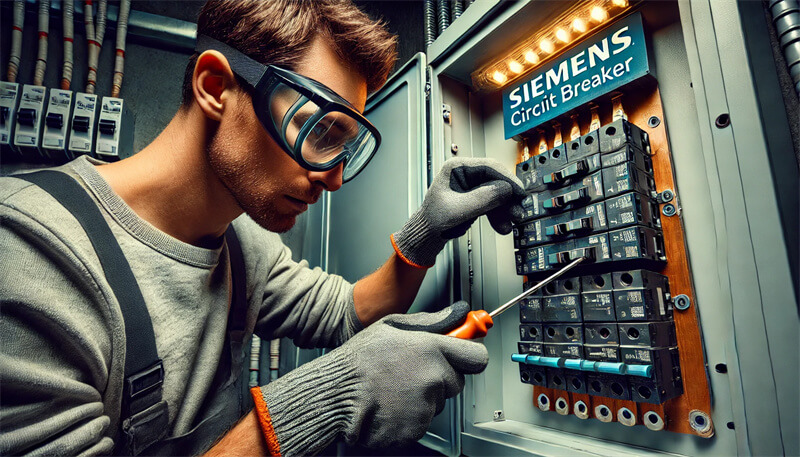Key Takeaways Table
| Question | Answer |
|---|---|
| What tools are needed? | Insulated screwdriver, non-contact voltage tester, rubber mat, insulated wire strippers, flashlight |
| What safety gear is necessary? | Insulated gloves, safety goggles |
| What is the first step in breaker removal? | Turn off the main breaker |
| How to check if the power is off? | Use a non-contact voltage tester |
| What to do if the circuit breaker won’t turn off? | Consult an electrician |
| Common issues to watch for? | Sparks when removing wires, loose or damaged wires, breaker won’t turn off |
Introduction
Working with electrical systems, especially when it involves removing a breaker from a Siemens panel, requires utmost caution and the right tools. At ControlNexus, we understand the importance of safety and precision in such tasks. This guide will walk you through the process step-by-step, ensuring you can safely and efficiently remove a circuit breaker from your Siemens panel.
Preparation and Tools
Before beginning the process, gather all necessary tools and safety gear:
Tools Required:
- Insulated screwdriver
- Non-contact voltage tester
- Rubber mat or plywood
- Insulated wire strippers
- Replacement circuit breaker (if needed)
- Flashlight or independent light source
Safety Gear:
- Insulated gloves
- Safety goggles
Having the right tools and gear not only makes the job easier but also ensures your safety throughout the process.
Step-by-Step Guide
1. Turn Off the Main Breaker
The first and most crucial step is to turn off the main breaker. This controls the flow of electricity to all branch circuits and is located at the top of the panel. Here’s how you do it:
- Open the panel door and locate the main breaker.
- Stand to the side of the panel to protect yourself from potential arc flashes.
- Use one hand to switch the main breaker to the OFF position.
This step de-energizes the branch circuit breakers but does not affect the utility lines connected to the panel.
2. Remove the Panel Cover
Once the main breaker is off, the next step is to remove the panel cover:
- Use a screwdriver to remove the screws holding the panel cover in place.
- Support the cover with one hand to prevent it from falling as you unscrew the last few screws.
- Carefully set the cover aside, ensuring you do not touch any exposed wires.
3. Test for Power
Even with the main breaker off, it’s essential to confirm that no live current remains in the panel:
- Use a non-contact voltage tester to check for any remaining voltage.
- Test the wires connected to the breaker you intend to remove.
- If the tester indicates live voltage, replace the panel cover and consult an electrician.
4. Turn Off the Branch Breaker
For added safety, turn off the specific branch breaker you will be working on:
- Locate the breaker you need to remove.
- Switch it to the OFF position.
This is an additional precaution to ensure no residual power flows through the breaker.
5. Disconnect the Wires
Now, you can proceed to disconnect the wires from the breaker:
- Use an insulated screwdriver to loosen the terminal screws.
- Carefully disconnect the wires attached to the breaker.
- Avoid touching any exposed wires or terminals.
6. Remove the Circuit Breaker
With the wires disconnected, you can now remove the breaker:
- Gently rock the breaker away from the center of the panel to unsnap it from the bus bar.
- Pull the breaker out carefully by hand.
If the breaker resists, do not use excessive force or tools. Instead, inspect for any obstructions or consult an electrician if needed.
7. Inspect the Circuit Breaker (If Replacing)
Before installing a new circuit breaker, it is crucial to inspect the old one for any signs of damage:
- Look for burnt contacts, discoloration, or loose connections.
- If any damage is found, replace the breaker with a new one of the same amperage rating.
8. Install the New Circuit Breaker (If Replacing)
If you’re replacing the breaker, follow these steps:
- Insert the new breaker into the panel by aligning it with the bus bar.
- Push the breaker into place until it snaps securely.
- Reconnect the wires to the terminals of the new breaker and tighten the screws.
9. Replace the Panel Cover
Once the new breaker is securely in place or the old breaker is successfully removed, you can replace the panel cover:
- Position the cover back on the panel.
- Use the screws to secure it in place, ensuring no wires are pinched or exposed.
10. Turn On the Power
After completing the installation or removal process, it’s time to restore power:
- First, turn on the main breaker.
- Then, switch each branch breaker back on, one at a time.
- Use a non-contact voltage tester to ensure each breaker is functioning properly.
Troubleshooting Common Issues
Even with careful execution, you might encounter some issues. Here’s how to handle common problems:
Circuit Breaker Won’t Turn Off
- This could be due to a jammed mechanism or a faulty breaker.
- Try gently wiggling the breaker switch. If it still doesn’t turn off, it might need replacement.
Sparks or Arcing When Removing Wires
- Sparks or arcing indicate that the circuit may still be live.
- Double-check that the main breaker is off and use a voltage tester to confirm.
Loose or Damaged Wires
- When reconnecting wires, ensure they are tightly secured and in good condition.
- Loose or damaged wires can lead to overheating and potential fire hazards.
Conclusion
Safely removing a breaker from a Siemens panel involves meticulous preparation and strict adherence to safety protocols. At ControlNexus, we prioritize safety and efficiency, offering detailed guides and professional advice on Siemens products.
For more information and professional guidance on Siemens PLCs, HMIs, and Inverters, visit:
For further assistance, explore our related guides:
- Understanding Siemens PLC Data Types
- Mastering Siemens PLC Software: A Comprehensive Guide to SIMATIC STEP 7 and TIA Portal
- Comprehensive Guide to Connecting Your Siemens PLC with an HMI
- How to Connect to Siemens PLC: A Comprehensive Guide
Additional Tips and FAQs
- Top Questions Asked:
- Tools needed for breaker removal: Insulated screwdriver, non-contact voltage tester, rubber mat, insulated wire strippers, flashlight
- Safety precautions: Always turn off the main breaker, use insulated tools, stand on a rubber mat, avoid touching exposed wires
- Signs of a faulty breaker: Frequent tripping, burnt contacts, discoloration, loose connections
- When to call an electrician: If unsure about any aspect of the process, dealing with a complex system, or encountering any issues
Stay safe and informed with ControlNexus, your trusted partner in Siemens industrial control products.



